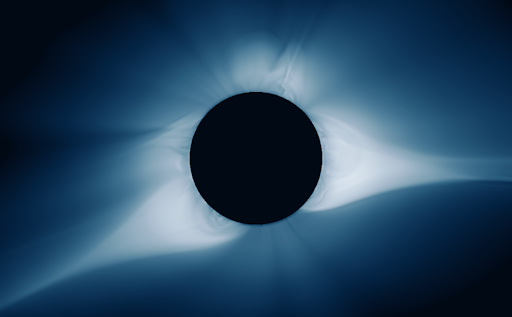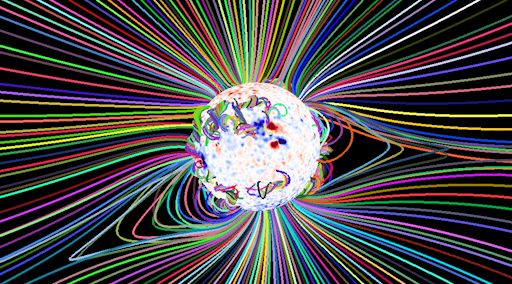Totale zonsverduistering 21 augustus 2017 in Amerika te zien
Dit is de eerstvolgende totale zonsverduistering waar heel veel liefhebbers naar uitkijken: een eclips in de zomer midden in de Verenigde Staten! Niet alleen zullen zeer veel Amerikanen hun best doen om in het eclipspad te komen, maar ook veel buitenlandse toeristen zullen deze gelegenheid aangrijpen voor een bezoek aan de VS.De grootste duur van de totaliteit van deze eclips is 2 m 40 s in de staat Kentucky. Maar zelfs twee minuten aan de westkust van de VS is nog interessant. Het eclipspad loopt van west naar oost, van Oregon over Idaho, Wyoming, Nebraska, Kansas, Missouri, Kentucky, Tennessee, naar South Carolina, en passeert daarbij toeristisch interessante plaatsen als Yellowstone National Park en Nashville.
Qua omstandigheden doet deze eclips denken aan die van 11 augustus 1999 in Europa: in de zomer dwars over een (redelijk) dichtbevolkt continent met goede autoverbindingen. Het is dus mogelijk om een interessante plek uit te zoeken, maar eventueel uit te wijken naar een andere plek met beter weer. Ook sterrenkundig zijn er overeenkomsten: beide eclipsen behoren tot dezelfde Saroscyclus.

Bovenstaande figuur toont het zichtbaarheidsgebied van de zonsverduistering van 21 augustus 2017. Het pad van de totale eclips begint ten westen van de VS, loopt dan dwars over Noord-Amerika, tot ver voorbij de oostkust. Aan weerszijden van het totaliteitspad is een veel breder gebied waar de zon slechts gedeeltelijk verduisterd wordt. De noordelijke grens van dit gebied loopt over het Noordpoolgebied. De zuidelijke grens loopt over Zuid-Amerika. De lichtblauwe lijnen verbinden de plaatsen waar de grootte van de eclips respectievelijk 80, 60, 40 en 20 procent bedraagt. De tijdstippen bij de groene lijnen geven aan wanneer de eclips daar maximaal is. Deze tijd is gegeven in UT; dat is 2 uur vroeger dan de zomertijd in Nederland. In de twee rode ovale gebieden is slechts een deel van de eclips te zien. In het linkerovaal is het einde van de eclips te zien, maar niet het begin. De zon komt er tijdens de zonsverduistering op. In het rechterovaal is wel het begin van de verduistering te zien, maar niet het einde, omdat de zon er tijdens de verduistering ondergaat. (Illustratie: F. Espenak/NASA)

Kaart van het eclipspad over de Verenigde Staten. (Illustratie: GreatAmericanEclipse.com)Gedetailleerde kaarten van het eclipsgebied vind je op de NASA-website.
AnimatieOnderstaande animatie, gemaakt met het programma Starry Night, toont hoe de schaduw van de maan over de aarde beweegt. We bekijken het vanaf een punt iets naast de zon, zodat we eerste de maan voor de aarde zien passeren, gevolgd door zijn schaduw op het oppervlak van de aarde.
Bron: http://www.zonsverduistering.nl/eclips2017augustus.html
Aangezien de totale verduistering in Amerika te zien is, hierbij enkele links die live gaan:
https://live.slooh.com/
https://www.nasa.gov/eclipselive
https://www.timeanddate.com/live/
https://www.exploratorium.edu/eclipse
http://www.popularmechanics.com/space/moon-mars/a25942/nasa-stream-total-solar-eclipse/
During a total eclipse, one of the most mesmerizing sights is the sun's ghostly corona. Gossamer streamers of gas in the sun's outer atmosphere suddenly become visible when the disk of the Moon blocks the glaring body of the sun. NASA-supported researchers at Predictive Science Inc. have just issued a computer model showing how the corona should look to the human eye on Aug.21st, the date of the Great American Solar Eclipse

"The sun's outer atmosphere is not a featureless layer of gas," says Pete Riley, a solar physicist at the company. "It is sculpted into beautiful, dynamic shapes by the sun's magnetic field." Riley and colleagues including Zoran Mikic and Cooper Downs figured out how to calculate and predict those shapes.
"Every day, NASA's Solar Dynamics Observatory measures magnetism at the surface of the sun," explains Mikic, who led the modeling effort. "We take the data and extrapolate it into the atmosphere using a computer running magnetohydrodynamic (MHD) codes."

Magnetic fields in the sun's atmosphere, calculated by the Predictive Science MHD code [more]
The result is a physics-based prediction of what people and cameras could see within the path of totality. "We are eager to find out how well our model results match reality," says Riley. "Ultimately, this may yield new insight into the complex physical processes that heat the solar corona and accelerate the solar wind."
Riley invites readers to return to their web site after the eclipse for a comparison of the predictions with actual observations. "Enjoy the eclipse!" he says.
Bron: http://www.spaceweather.com/
"A partial eclipse is very interesting. It bears almost no relation to a total eclipse. Seeing a partial eclipse bears the same relation to seeing a total eclipse as kissing a man does to marrying him, or as flying in an airplane does to falling out of an airplane."
Indeed, during the minutes of totality, the whole world changes. Saying that day turns into night barely scratches the surface of it. The shadow of the Moon lances down to Earth from a quarter million miles away. On one end is you; on the other end is a million square miles of dusty lunar terrain. You're connected, and you can feel the cold.

Darkness inside the path of totality has an alien quality. Because the shadow is only 70 miles wide, you can see daylight at the edges even while you stand in the dark core. This distant scattered light produces a slight reddish glow and unusual shadow effects. Many birds stop singing, daytime flower blossoms begin to close as if for the night, and bees return to their hives.
"What you see in an eclipse is entirely different from what you know," says Dillard, whose brilliant essay "Total Eclipse" is a must-read for anyone deciding whether to stay home ... or have their minds blown.
Bron: http://www.spaceweather.com/
Om alvast wat warm te lopen  :
:
Informatievideo's:
Video's van vorige eclipsen:
Aangezien de totale verduistering in Amerika te zien is, hierbij (nogmaals) enkele links die live gaan:
https://live.slooh.com/
https://www.nasa.gov/eclipselive
https://www.timeanddate.com/live/
https://www.exploratorium.edu/eclipse
http://www.popularmechanics.com/space/moon-mars/a25942/nasa-stream-total-solar-eclipse/
| Gewijzigd: 17 augustus 2017, 15:24 uur, door Joyce.s
Nog een aantal uurtjes wachten en dan is het tijd voor de TOTALE ZONSVERDUISTERING!
In Oregon is de totaliteit om 19:15 uur (nederlandse tijd), en south Carolina 20:45 uur (wederom nederlandse tijd). De live uitzendingen beginnen uiteraard eerder.
Het pad van de zonsverduistering is als volg:
Oregon, Idaho, Montana, Wyoming, Nebraska, Kansas, Iowa, Missouri, Illinois, Kentucky, Tennessee, Georgia, North Carolina, South Carolina.
Gaat iedereen in het pad van de zonsverduistering ook daadwerkelijk dit bijzondendere fenomeen zien? Dat is afhankelijk van de bewolking.
Daarom hierbij alvast de satellietbeelden:
Wil je vlak voor de verduistering per gebied snel naar een update kijken over de weersomstandigheden, zie dan bv.:
http://www.goes.noaa.gov/GSSLOOPS/ecir.html
http://eclipsophile.com/real-time-weather/
to be continued........
| Gewijzigd: 21 augustus 2017, 10:38 uur, door Joyce.s
#Eclipse2017 ABC News report in 1979 about the next eclipse in 2017 pic.twitter.com/J5PDjibwzU
— iaidi wm (@iaidiWM) 21 augustus 2017
Here we go!!! Good luck everyone chasing #Eclipse2017
— Reed Timmer (@ReedTimmerAccu) 21 augustus 2017
#SolarEclipse from 36,000' today! Got the #GoPro ready! #Eclipse #travel #eclipse2017 #SolarEclipse17 #SolarEclispe2017 pic.twitter.com/VUlkHAjFMa
— Sean Brown (@imseanbrown) 21 augustus 2017
History's earliest known eclipse photo. It was taken by Julius Berkowski at Royal Observatory in Prussia, on July 28, 1851.#EclipseDay pic.twitter.com/JhjBrtcbmg
— Ray Davis (@AnunnakiAwake) 21 augustus 2017
What will the weather look like where you are for #Eclipse2017? Here's what to expect: https://t.co/tkl8RYdNNe pic.twitter.com/H7xvsYPV05
— Jake Cornwall (@JakeM_1998) 21 augustus 2017
When your son says he wants to see the #eclipse2017 in totality -you get up really early. South Carolina-bound. pic.twitter.com/wHEOVf1bq8
— Jim Issokson (@JimIssokson) 21 augustus 2017
The Great American Solar Eclipse of 2017 Is Happening Today https://t.co/E4eb28HQfF pic.twitter.com/mreAkvn35E
— SPACE.com (@SPACEdotcom) 21 augustus 2017
The #ISS crew has a #SolarEclipse front-row seat! Astronaut @AstroKomrade describes what they'll see: https://t.co/QQHWTVyNaK @SPACEdotcom
— Enterprise.nxt (@Enterprisenxt) 20 augustus 2017
Space Science #ImageOfTheWeek: Before the #solareclipse: #Sun seen by SOHO & Proba-2 earlier this a.m https://t.co/Sdt9wcI939 #Eclipse2017 pic.twitter.com/OiCUMyumMH
— ESA Science (@esascience) 21 augustus 2017
@PerezAyucar, one of the #CESAR astronomers on-site for the #Eclipse2017, fine tuning the telescope #CESARobserve. We are ready, are you? pic.twitter.com/g8L8u0skqN
— CESAR (@esa_cesar_en) 20 augustus 2017
Hierbij nogmaals enkele links:
https://www.timeanddate.com/live/
https://live.slooh.com/redirect-confirmation
http://www.ustream.tv/nasahdtv
http://cesar.esa.int/
Birds are being fueled! Takeoff estimated 10:15am CDT. Preflight briefing in a few minutes. #eclipse2017 #WB-57 @NASA @NASA_Johnson pic.twitter.com/p9ARqTc70o
— Amir Caspi (@astronamir) 21 augustus 2017
I-25 near Glendo #eclipse2017 #parkinglot pic.twitter.com/Aeq4dCo8zt
— Gordon Dewis (@KeeperOfMaps) 21 augustus 2017
The @Space_Station is predicted to pass through the Moon’s penumbra shadow 3x! Stay tuned for possible imagery of #eclipse2017 from space! pic.twitter.com/ytzC93ADUs
— NASA Astromaterials (@Astromaterials) 19 augustus 2017
Our @LSUphysastro team is set up at Saluki Stadium in Carbondale IL for a balloon experiment during the #Eclipse2017 pic.twitter.com/IAjHz58FRt
— LSU Science Dean (@LSUscidean) 21 augustus 2017
Intrepid crew (pilots, operators, comm) giving pre-flight briefing, planning the procedures and routes. We are in great hands! #eclipse2017 pic.twitter.com/jPfStuz1yP
— Amir Caspi (@astronamir) 21 augustus 2017
All set up with screaming fast internet access. #stratostar0149 #eclipseballooning #eclipse2017 #nasaspacegrant pic.twitter.com/yp0obtAKHG
— nearspacescience (@nearspacesci) 21 augustus 2017
Clever but dangerous.#Eclipse2017 pic.twitter.com/lFVRUO6NvG
— Hessian (@hessian) 21 augustus 2017
Setting up equipment for the livestream! #eclipse2017 #umaine #clemson #MaineUp #winning #NasaSpaceGrant #cantstopwontstop pic.twitter.com/4fLrUkQrnS
— UMHAB (@UMHAB) 21 augustus 2017
Briefing complete. Birds ready. Crew suited and seated, pre-flight prep underway. Takeoff in 55 minutes. #eclipse2017 @NASA @NASA_Johnson pic.twitter.com/kMPMDe8Mgp
— Amir Caspi (@astronamir) 21 augustus 2017
All hands (cameras) on deck for #SolarEclipse2017 today… What will you take pictures with? Don’t forget to protect your eyeballs! pic.twitter.com/6hOqNkrLjB
— Jack Fischer (@Astro2fish) 21 augustus 2017
Media lineup to cover our WB-57 #eclipse2017 mission. Everyone's excited! Cloudy here, but the view at 50,000 feet will be amazing! @NASA pic.twitter.com/4Tmu5tMUuf
— Amir Caspi (@astronamir) 21 augustus 2017

 Totale zonsverduistering 21 augustus
Totale zonsverduistering 21 augustus




